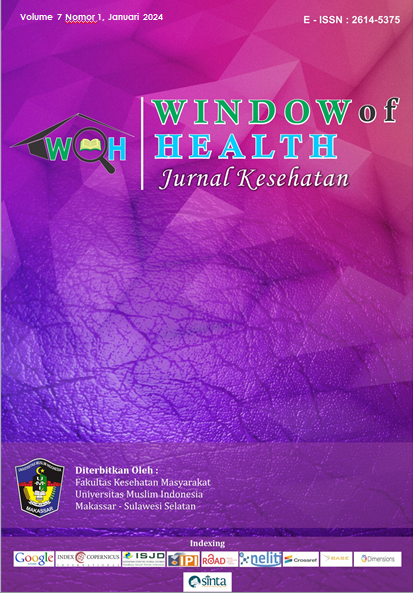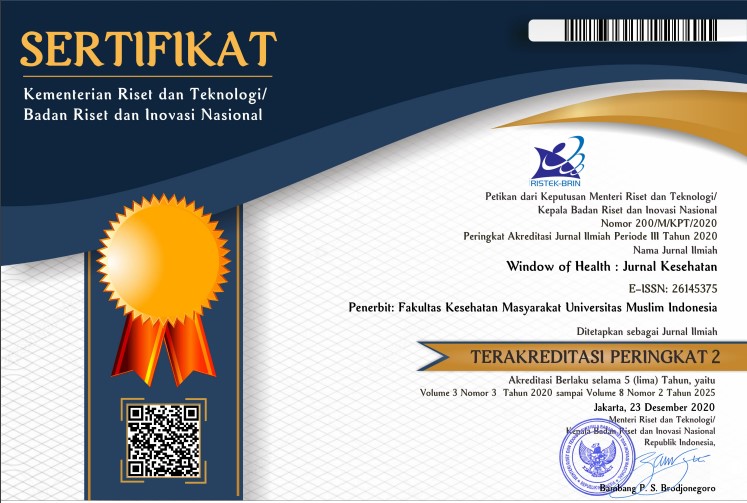Controlling Model For Risk Factors Of Stunting Incident
Abstract
Stunting is the condition where the children have stunted growth and development refers to weight/age (TB/U). In 2015-2017, there were 19,4%, 18,9% and 21,3% cases in West Sumatra. Pasaman district had the highest percentage of stunting from 19 Cities in West Sumatera, which is 21,1%, 25,7%, and 25% cases. The purpose of this study was to analyze the risk factor control model for stunting in toddlers in the Pasaman district. This study was an observational analytic study with an unmatched case-control design. The subject of this study was the 35 families who had children 12-59 months with stunting cases and another 35 group control in Pasaman district. Data were collected by using a questionnaire to measure stunting risk factors. Data was analyzed by using univariate, bivariate, and multivariate analysis with regression and backward methods. The result of the study showed that “father education level” as a stunting risk factor had a P value=0,048 and “family income” with P value = 0,015, while history of birth weight had a P value of 0,08. The final result (sixth step) showed that the baby's birth weight variable had the odds ratio eβ=31,578 when analyzed simultaneously with another variable (parenting and father’s education level). Conclusion: baby birth weight variable simultaneously with parenting and the father’s educational level affected the incident of stunting in toddlers (eβ=31,578). It is necessary to increase family empowerment to control the cases of stunting related to the nutrition of pregnant mothers by improved child care, parenting in feeding, and increased family income.
References
World Health Organization. (2014) Childhood Stunting: Challenges and opportunities. Report of a Promoting Healthy Growth and Preventing Childhood Stunting colloquium., WHO Geneva
Marini, A. and Rokx, C. (2016) Standing Tall: Peru’s Success in Overcoming its Stunting Crisis, Public Dissclosure.
MCA Indonesia (2013) ‘Stunting dan Masa Depan Indonesia’, Millennium Challenge Account - Indonesia, 2010, pp. 2–5. Available at: www.mca-indonesia.go.id.
Sumbar, D. P. (2018) Laporan Status Gizi Balita dan Data Indikator Gizi Kab/Kota. Padang.
Zaif, R. M., Wijaya, M. and Hilmanto, D. (2016) ‘Hubungan Antara Riwayat Status Gizi Ibu Masa Kehamilan dengan Pertumbuhan Anak Balita di Kecamatan Soreang Kabupaten Bandung’, Jsk, 2(3), pp. 156–163.
Senbanjo, I. O. et al. (2013) ‘Maternal and child under-nutrition in rural and urban communities of Lagos state , Nigeria : the relationship and risk factors’, Biomed Central, 6, p. 10. doi: https://dx.https://dx.doi.org/10.1186%2F1756-0500-6-286.
Schlesselman, J.J. (1982) Case-control studies, design, conduct, analysis. Oxford University Press, New York.
Bappenas. (2018). Rencana Aksi Nasional Dalam Rangka Penurunan Stunting. Rembuk
Stunting: Jakarta
Lemeshow, S., Hosmer jr, D.W., Klar, J. & Lwanga, S.K. (1997) Besar sampel dalam penelitian kesehatan. Alih bahasa Pramono, D. Yogyakarta: Gadjah Mada University Press
Murti, 1997. Prinsip dan Metode Riset Epidemiologi. Yogyakarta: Gadjah Mada
University Press.
Soetjiningsih, IG. N. Gde Ranuh. Tumbuh Kembang Anak Edisi 2. Jakarta:
Penerbit Buku Kedokteran EGC. 2013
Nurhasanah, Defisit Berat Asupan Energi dan Protein Berhubungan dengan Stunting pada Anak Usia 12-24 Bulan
di Desa Plerean, Sumberjambe, Jember, Journal of Agromedicine and Medical Sciences. 2021. 7(2): 116-120
l-Rahmad, A. H. & A. Miko. (2016). Kajian stunting pada anak balita berdasarkan pola
asuh dan pendapatan keluarga di Kota Banda Aceh. Jurnal Kesmas Indonesia, 8(2):
-79
Ni’mah, Khoirun dan S. R. Nadhiroh. 2015. Faktor yang berhubungan dengan kejadian stunting pada balita. Media Gizi Indonesia. 10(1): 13–19
R. Nasikhah, and A. Margawati, Faktor Risiko Kejadian Stunting Pada Balita Usia 24 – 36 Bulan Di Kecamatan Semarang Timur. Journal of Nutrition College, vol. 1, no. 1, pp. 176-184, Oct. 2012.
Rahayu. A, Khairiyati, L. 2014. Resiko Pendidikan Ibu Terhadap Kejadian
Stunting pada Anak 6-23 Bulan. Vol. 37 : Hal 129-136. Peneliti. Gizi Makanan
Mardani, R., Wetasin, K., & Suwanwaiphatthana, W. (2015). Faktor prediksi yang mempengaruhi
terjadinya stunting pada anak usia dibawah lima tahun. Jurnal Kesehatan Masyarakat,
,1–7.
Abenhaim HA, Kinch RA and Usher R. Effect of prepregnancy body
mass indexcategories on obstetric and neonatal outcomes. Obstetric and
Gynaecologic. 2004
Candra, A. 2013. Hubungan underlying factors dengan kejadian stuntingpada anak 1-2 th.Journal of Nutrition and Health. 1(1).
Geiby waladow. Hubungan pola makan dengan status gizi pada anak usia 3-5 tahun di wilayah kerja puskesmas tompaso kecamatan tompaso, ejournal keperawatan (e-Kp) Volume 1. Nomor 1. Agustus 2015
Copyright (c) 2024 Lisma Evareny Eva

This work is licensed under a Creative Commons Attribution-NonCommercial-ShareAlike 4.0 International License.








